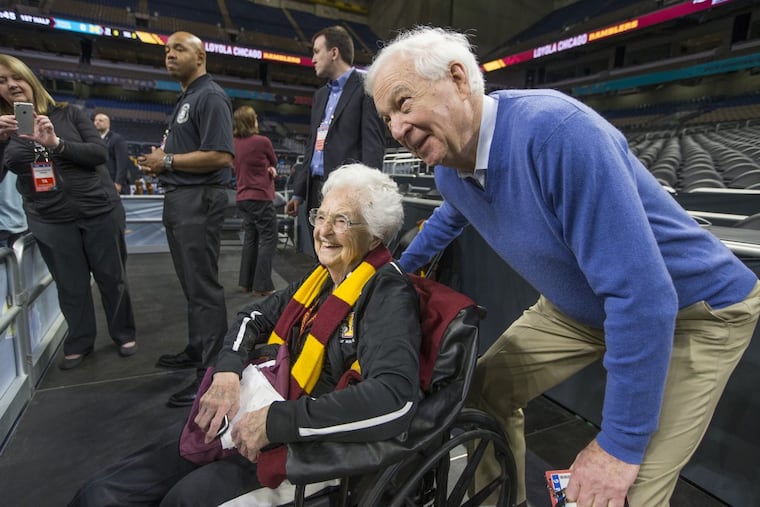Don't forget: Sister Jean is more than just a meme | Mike Sielski
The 98-year-old nun from Loyola-Chicago has become a celebrity ahead of the Final Four. But it's easy to forget why she and others like her are truly special.

SAN ANTONIO – There were already probably 200 people in a room here at the Alamodome on Friday morning, all of them waiting for Sister Jean Dolores-Schmidt of Loyola Chicago, and another 50 to 100 would soon squeeze themselves in before she arrived, and just before she did, they made ready the way. Three arena workers unfurled a black metal ramp, dropping it to the floor with a loud and jarring clank, so that Tom Hitcho, a longtime Loyola athletic administrator, could push her and her wheelchair behind a table, so that she could face the phalanx of cameras and media members who had come to cover the oh-so-adorable story of the 98-year-old nun who had made it to the Final Four.
"I never even imagined two or three, let alone this large group," she said. "Everything just seemed to mushroom, and I could never tell you how that happens."
It happens for several reasons, and the Cinderella nature of Loyola's run in this tournament – the 11th-seeded Ramblers rambling through the South Region and to a national semifinal game Saturday against Michigan – is just one. The structure of the event lends itself to turning a sister of the Charity of the Blessed Virgin Mary into a pop-culture heroine. The tournament lasts three weeks and introduces the country to new faces and stories, and it can sweep up a lovable character in its tailwind. The scope of the Sister Jean phenomenon, with the reach of social media and the sheer volume of coverage, may be relatively new, but the template isn't.
In 1985, as Villanova kept winning games on its way to an improbable national championship, the sight of former trainer Jake Nevin – curled up in a wheelchair near the Wildcats' bench, Lou Gehrig's disease turning his body to wax – became a staple of every telecast. Nevin had been a fixture in the Villanova program, time and his illness transforming him from the ornery cuss who taped ankles into the resident prankster who dropped cigar butts in players' sneakers before games.
From his Wayne, Pa., home, one of the stars of that 1985 team, Harold Jensen, has watched most of this year's tournament, and he has noticed the way that the TV cameras manage to find Sister Jean, just like they always found Nevin.
"To me, what I think they see in her and what we saw in Jake is a commitment to something and a longevity," Jensen said in a phone interview. "To build a good program, it takes that special commitment. Jake was at Villanova for more than 50 years. He gave his life to Nova, just as she has to her faith and that school. People can attach to that.
"You draw on things that have meaning to you. It may be a parent who really helped create an opportunity in their life. It may be Sister Jean. I think for all of us, Jake was an inspiration because of his dedication to the school. We all looked at that as something special."
Jensen was getting at something profound there: the substance of Jake Nevin and Sister Jean, the loyalty and service that make them beloved in the first place, the stuff that can get lost in the celebrity that we suddenly bestow on such figures for a brief period of time. (After every game, for instance, she sends personal emails of encouragement to the Loyola players.) In the race for ratings and clicks and money, money, money, it's as if they become official team mascots, a vaguely demeaning status that reduces them to nothing more than cute little old people who get head rubs and sweaty hugs and can sell bobbleheads – Sister Jean has two – as press conferences and post-victory celebrations rage around them. Sister Jean wore a maroon-and-gold scarf that was draped over a black long-sleeved shirt with a large gold "L" on its left lapel, and you could practically hear the oohs and awws as she answered even the most patronizing and frivolous of questions.
How cool is it to see your face on socks and T-shirts?
Have you had the chance to tour the city and party?
Do you think God is a basketball fan?
"He probably is," Sister Jean said in response to that last one. "And he's probably a basketball fan more of the NCAA than the NBA. … And I say that because these young people are playing with their hearts and not for any financial assistance."
It's easy enough to be snarky or cynical over Sister Jean's naïve vision of the college basketball industrial complex. But given her 81 years of religious life and her 27 years at Loyola as an adviser, a counselor, and the men's basketball team's chaplain, it's natural for her to accentuate her relationship with the students there, and that connection is as real as the billions of dollars that the NCAA, CBS, and Turner are happy to make on those kids' backs. It gets to the heart of who she really is, who she has been for a long time. She's more than just a lucky charm. She's more than just a meme. It was just so hard to see that Friday morning, especially with an iPhone camera in front of your face.